Case Study: Nancy's Mental Health Assessment and Treatment Plan
VerifiedAdded on 2020/03/23
|8
|2179
|36
Case Study
AI Summary
This case study examines Nancy's mental health, presenting a comprehensive analysis of her condition. The introduction highlights the importance of mental health assessments and the need for timely treatment. The case outline details Nancy's history of anxiety and related behaviors. Ethical, legal, and policy considerations are discussed, emphasizing the importance of a recovery-oriented approach and maintaining confidentiality. A SWOT analysis identifies Nancy's strengths, weaknesses, opportunities, and threats. The treatment model involves a holistic approach with counseling, including a psychodynamic theory. Additional services, such as crisis support, are recommended. The conclusion underscores the importance of a comprehensive approach to mental health treatment, highlighting the roles of healthcare professionals, family support, and ethical considerations. References to relevant literature are provided, solidifying the study's foundation.
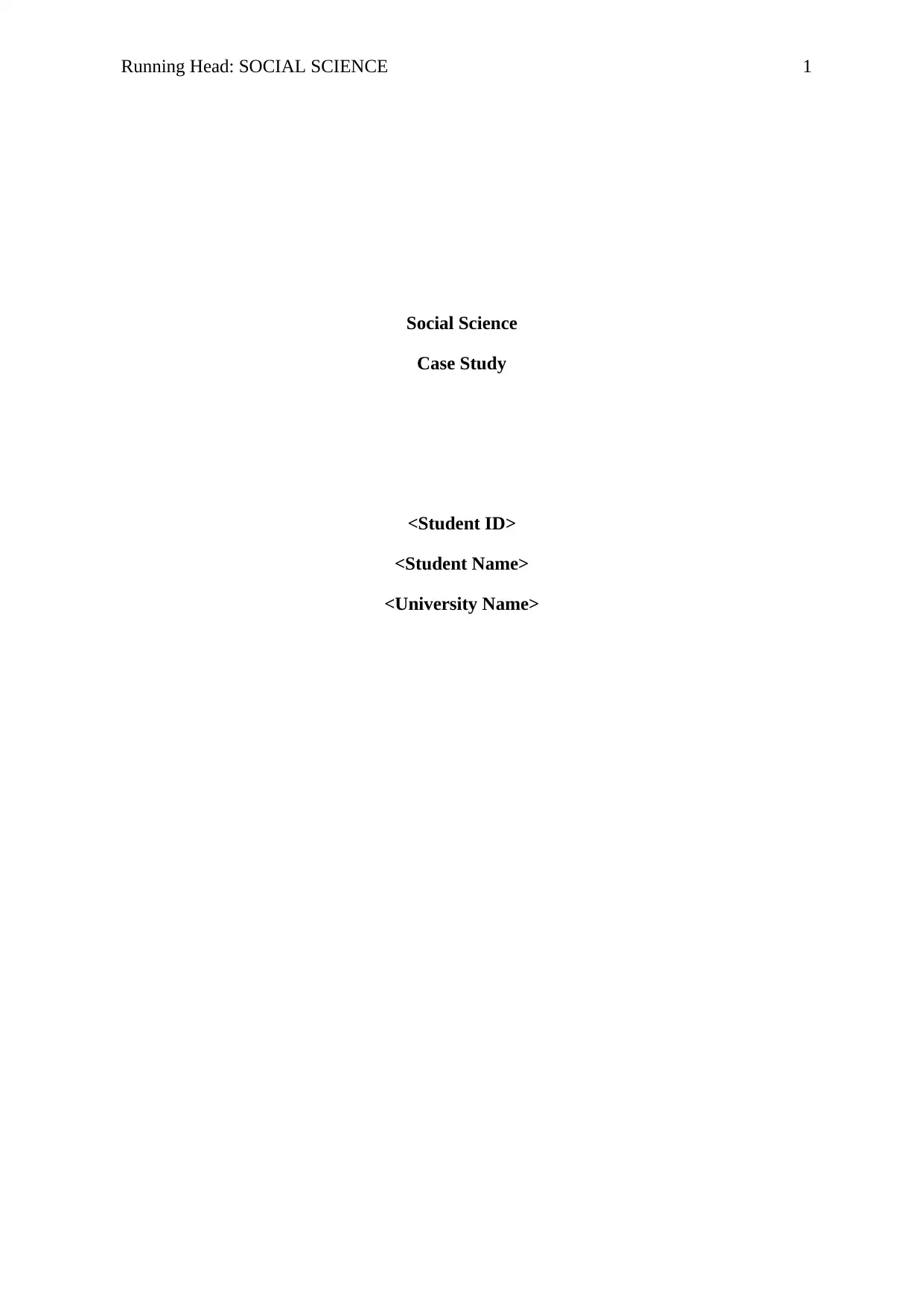
Running Head: SOCIAL SCIENCE 1
Social Science
Case Study
<Student ID>
<Student Name>
<University Name>
Social Science
Case Study
<Student ID>
<Student Name>
<University Name>
Paraphrase This Document
Need a fresh take? Get an instant paraphrase of this document with our AI Paraphraser

SOCIAL SCIENCE 2
Contents
Introduction................................................................................................................................3
Case Outline...............................................................................................................................3
Ethical, Legal and Policy concerns............................................................................................3
SWOT Analysis of Nancy’s life................................................................................................4
Treatment Model........................................................................................................................5
Counseling Approach.................................................................................................................5
Additional services.....................................................................................................................6
Necessary considerations in the process....................................................................................6
Conclusion..................................................................................................................................6
References..................................................................................................................................7
Contents
Introduction................................................................................................................................3
Case Outline...............................................................................................................................3
Ethical, Legal and Policy concerns............................................................................................3
SWOT Analysis of Nancy’s life................................................................................................4
Treatment Model........................................................................................................................5
Counseling Approach.................................................................................................................5
Additional services.....................................................................................................................6
Necessary considerations in the process....................................................................................6
Conclusion..................................................................................................................................6
References..................................................................................................................................7
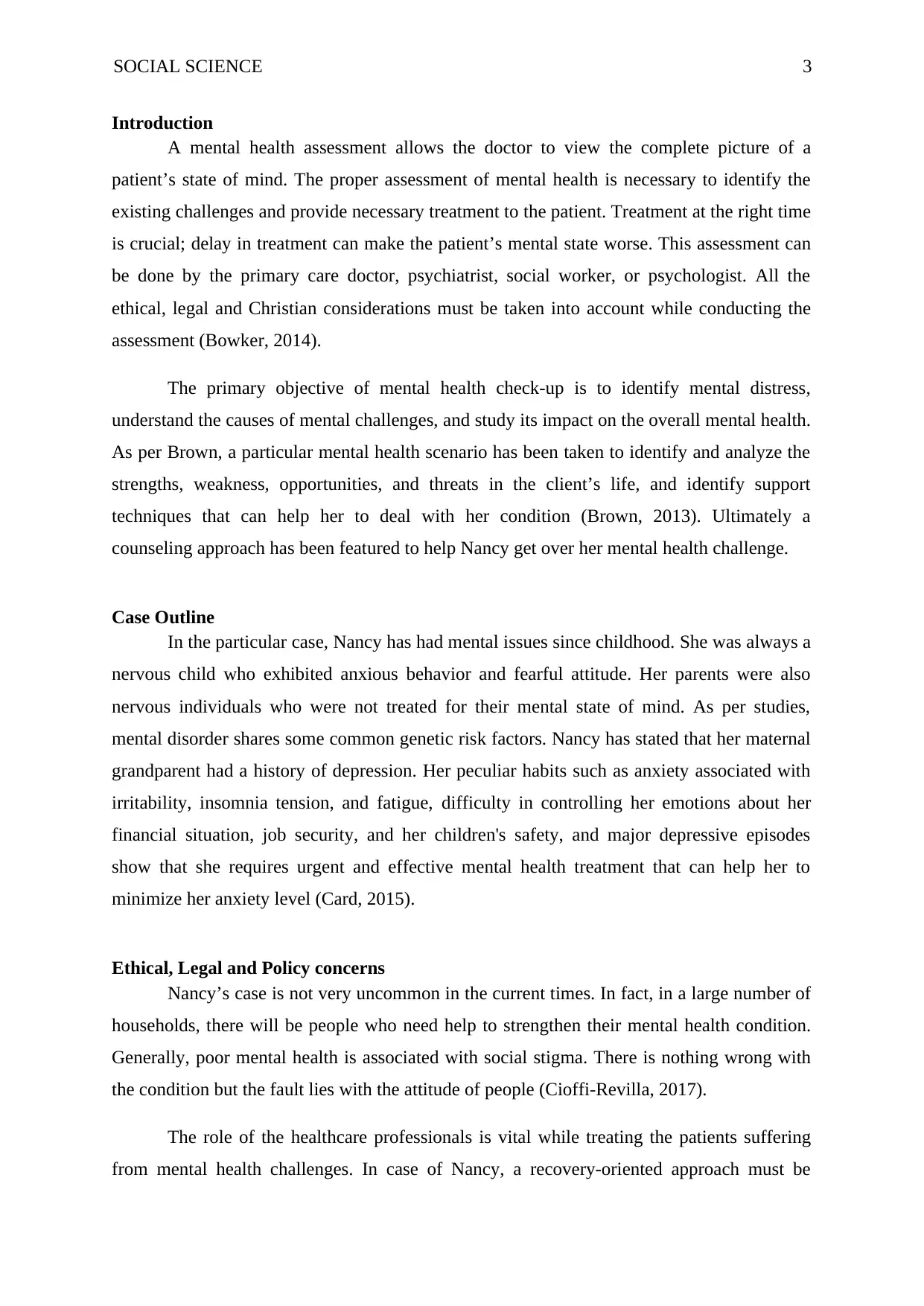
SOCIAL SCIENCE 3
Introduction
A mental health assessment allows the doctor to view the complete picture of a
patient’s state of mind. The proper assessment of mental health is necessary to identify the
existing challenges and provide necessary treatment to the patient. Treatment at the right time
is crucial; delay in treatment can make the patient’s mental state worse. This assessment can
be done by the primary care doctor, psychiatrist, social worker, or psychologist. All the
ethical, legal and Christian considerations must be taken into account while conducting the
assessment (Bowker, 2014).
The primary objective of mental health check-up is to identify mental distress,
understand the causes of mental challenges, and study its impact on the overall mental health.
As per Brown, a particular mental health scenario has been taken to identify and analyze the
strengths, weakness, opportunities, and threats in the client’s life, and identify support
techniques that can help her to deal with her condition (Brown, 2013). Ultimately a
counseling approach has been featured to help Nancy get over her mental health challenge.
Case Outline
In the particular case, Nancy has had mental issues since childhood. She was always a
nervous child who exhibited anxious behavior and fearful attitude. Her parents were also
nervous individuals who were not treated for their mental state of mind. As per studies,
mental disorder shares some common genetic risk factors. Nancy has stated that her maternal
grandparent had a history of depression. Her peculiar habits such as anxiety associated with
irritability, insomnia tension, and fatigue, difficulty in controlling her emotions about her
financial situation, job security, and her children's safety, and major depressive episodes
show that she requires urgent and effective mental health treatment that can help her to
minimize her anxiety level (Card, 2015).
Ethical, Legal and Policy concerns
Nancy’s case is not very uncommon in the current times. In fact, in a large number of
households, there will be people who need help to strengthen their mental health condition.
Generally, poor mental health is associated with social stigma. There is nothing wrong with
the condition but the fault lies with the attitude of people (Cioffi-Revilla, 2017).
The role of the healthcare professionals is vital while treating the patients suffering
from mental health challenges. In case of Nancy, a recovery-oriented approach must be
Introduction
A mental health assessment allows the doctor to view the complete picture of a
patient’s state of mind. The proper assessment of mental health is necessary to identify the
existing challenges and provide necessary treatment to the patient. Treatment at the right time
is crucial; delay in treatment can make the patient’s mental state worse. This assessment can
be done by the primary care doctor, psychiatrist, social worker, or psychologist. All the
ethical, legal and Christian considerations must be taken into account while conducting the
assessment (Bowker, 2014).
The primary objective of mental health check-up is to identify mental distress,
understand the causes of mental challenges, and study its impact on the overall mental health.
As per Brown, a particular mental health scenario has been taken to identify and analyze the
strengths, weakness, opportunities, and threats in the client’s life, and identify support
techniques that can help her to deal with her condition (Brown, 2013). Ultimately a
counseling approach has been featured to help Nancy get over her mental health challenge.
Case Outline
In the particular case, Nancy has had mental issues since childhood. She was always a
nervous child who exhibited anxious behavior and fearful attitude. Her parents were also
nervous individuals who were not treated for their mental state of mind. As per studies,
mental disorder shares some common genetic risk factors. Nancy has stated that her maternal
grandparent had a history of depression. Her peculiar habits such as anxiety associated with
irritability, insomnia tension, and fatigue, difficulty in controlling her emotions about her
financial situation, job security, and her children's safety, and major depressive episodes
show that she requires urgent and effective mental health treatment that can help her to
minimize her anxiety level (Card, 2015).
Ethical, Legal and Policy concerns
Nancy’s case is not very uncommon in the current times. In fact, in a large number of
households, there will be people who need help to strengthen their mental health condition.
Generally, poor mental health is associated with social stigma. There is nothing wrong with
the condition but the fault lies with the attitude of people (Cioffi-Revilla, 2017).
The role of the healthcare professionals is vital while treating the patients suffering
from mental health challenges. In case of Nancy, a recovery-oriented approach must be
⊘ This is a preview!⊘
Do you want full access?
Subscribe today to unlock all pages.

Trusted by 1+ million students worldwide
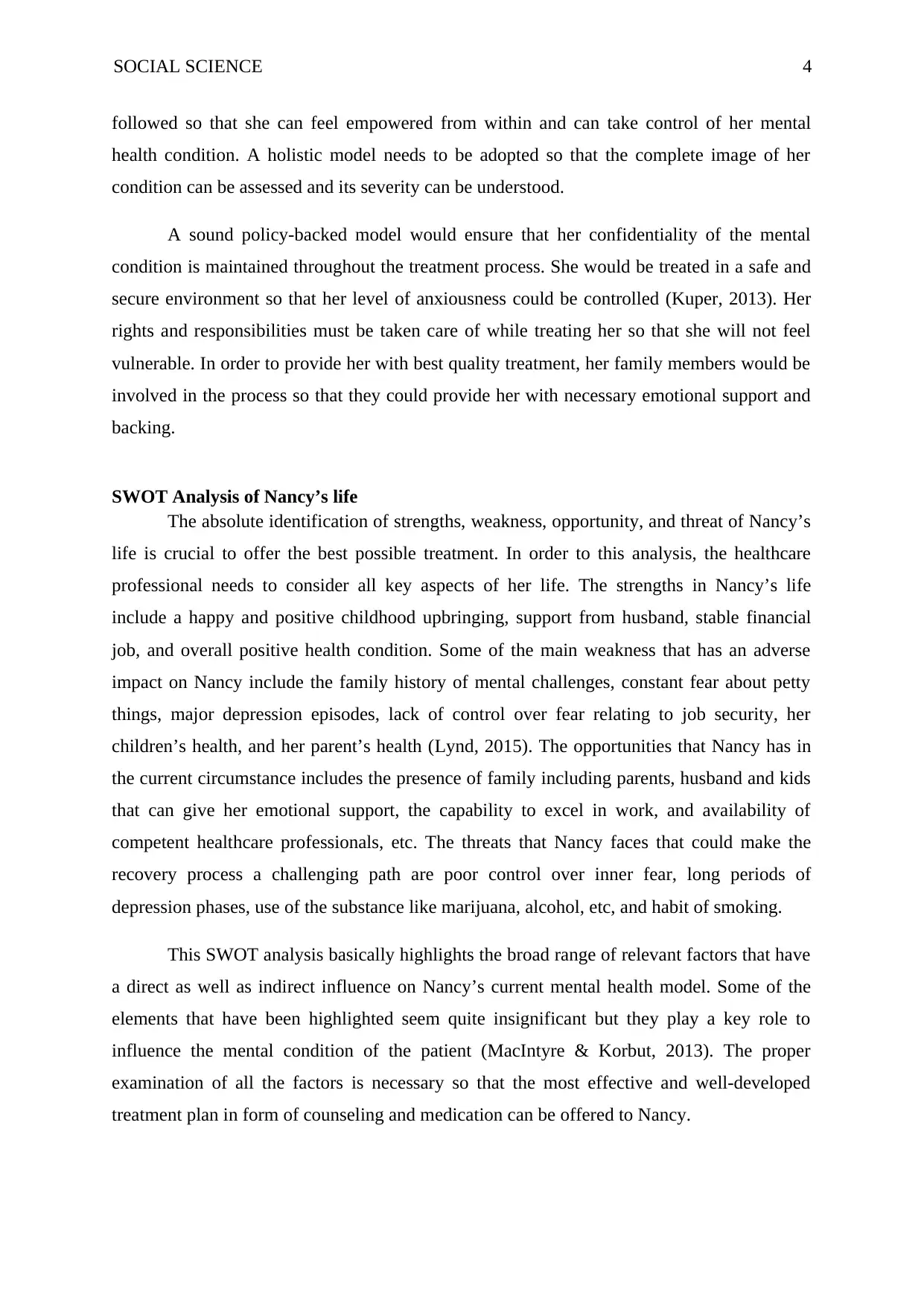
SOCIAL SCIENCE 4
followed so that she can feel empowered from within and can take control of her mental
health condition. A holistic model needs to be adopted so that the complete image of her
condition can be assessed and its severity can be understood.
A sound policy-backed model would ensure that her confidentiality of the mental
condition is maintained throughout the treatment process. She would be treated in a safe and
secure environment so that her level of anxiousness could be controlled (Kuper, 2013). Her
rights and responsibilities must be taken care of while treating her so that she will not feel
vulnerable. In order to provide her with best quality treatment, her family members would be
involved in the process so that they could provide her with necessary emotional support and
backing.
SWOT Analysis of Nancy’s life
The absolute identification of strengths, weakness, opportunity, and threat of Nancy’s
life is crucial to offer the best possible treatment. In order to this analysis, the healthcare
professional needs to consider all key aspects of her life. The strengths in Nancy’s life
include a happy and positive childhood upbringing, support from husband, stable financial
job, and overall positive health condition. Some of the main weakness that has an adverse
impact on Nancy include the family history of mental challenges, constant fear about petty
things, major depression episodes, lack of control over fear relating to job security, her
children’s health, and her parent’s health (Lynd, 2015). The opportunities that Nancy has in
the current circumstance includes the presence of family including parents, husband and kids
that can give her emotional support, the capability to excel in work, and availability of
competent healthcare professionals, etc. The threats that Nancy faces that could make the
recovery process a challenging path are poor control over inner fear, long periods of
depression phases, use of the substance like marijuana, alcohol, etc, and habit of smoking.
This SWOT analysis basically highlights the broad range of relevant factors that have
a direct as well as indirect influence on Nancy’s current mental health model. Some of the
elements that have been highlighted seem quite insignificant but they play a key role to
influence the mental condition of the patient (MacIntyre & Korbut, 2013). The proper
examination of all the factors is necessary so that the most effective and well-developed
treatment plan in form of counseling and medication can be offered to Nancy.
followed so that she can feel empowered from within and can take control of her mental
health condition. A holistic model needs to be adopted so that the complete image of her
condition can be assessed and its severity can be understood.
A sound policy-backed model would ensure that her confidentiality of the mental
condition is maintained throughout the treatment process. She would be treated in a safe and
secure environment so that her level of anxiousness could be controlled (Kuper, 2013). Her
rights and responsibilities must be taken care of while treating her so that she will not feel
vulnerable. In order to provide her with best quality treatment, her family members would be
involved in the process so that they could provide her with necessary emotional support and
backing.
SWOT Analysis of Nancy’s life
The absolute identification of strengths, weakness, opportunity, and threat of Nancy’s
life is crucial to offer the best possible treatment. In order to this analysis, the healthcare
professional needs to consider all key aspects of her life. The strengths in Nancy’s life
include a happy and positive childhood upbringing, support from husband, stable financial
job, and overall positive health condition. Some of the main weakness that has an adverse
impact on Nancy include the family history of mental challenges, constant fear about petty
things, major depression episodes, lack of control over fear relating to job security, her
children’s health, and her parent’s health (Lynd, 2015). The opportunities that Nancy has in
the current circumstance includes the presence of family including parents, husband and kids
that can give her emotional support, the capability to excel in work, and availability of
competent healthcare professionals, etc. The threats that Nancy faces that could make the
recovery process a challenging path are poor control over inner fear, long periods of
depression phases, use of the substance like marijuana, alcohol, etc, and habit of smoking.
This SWOT analysis basically highlights the broad range of relevant factors that have
a direct as well as indirect influence on Nancy’s current mental health model. Some of the
elements that have been highlighted seem quite insignificant but they play a key role to
influence the mental condition of the patient (MacIntyre & Korbut, 2013). The proper
examination of all the factors is necessary so that the most effective and well-developed
treatment plan in form of counseling and medication can be offered to Nancy.
Paraphrase This Document
Need a fresh take? Get an instant paraphrase of this document with our AI Paraphraser
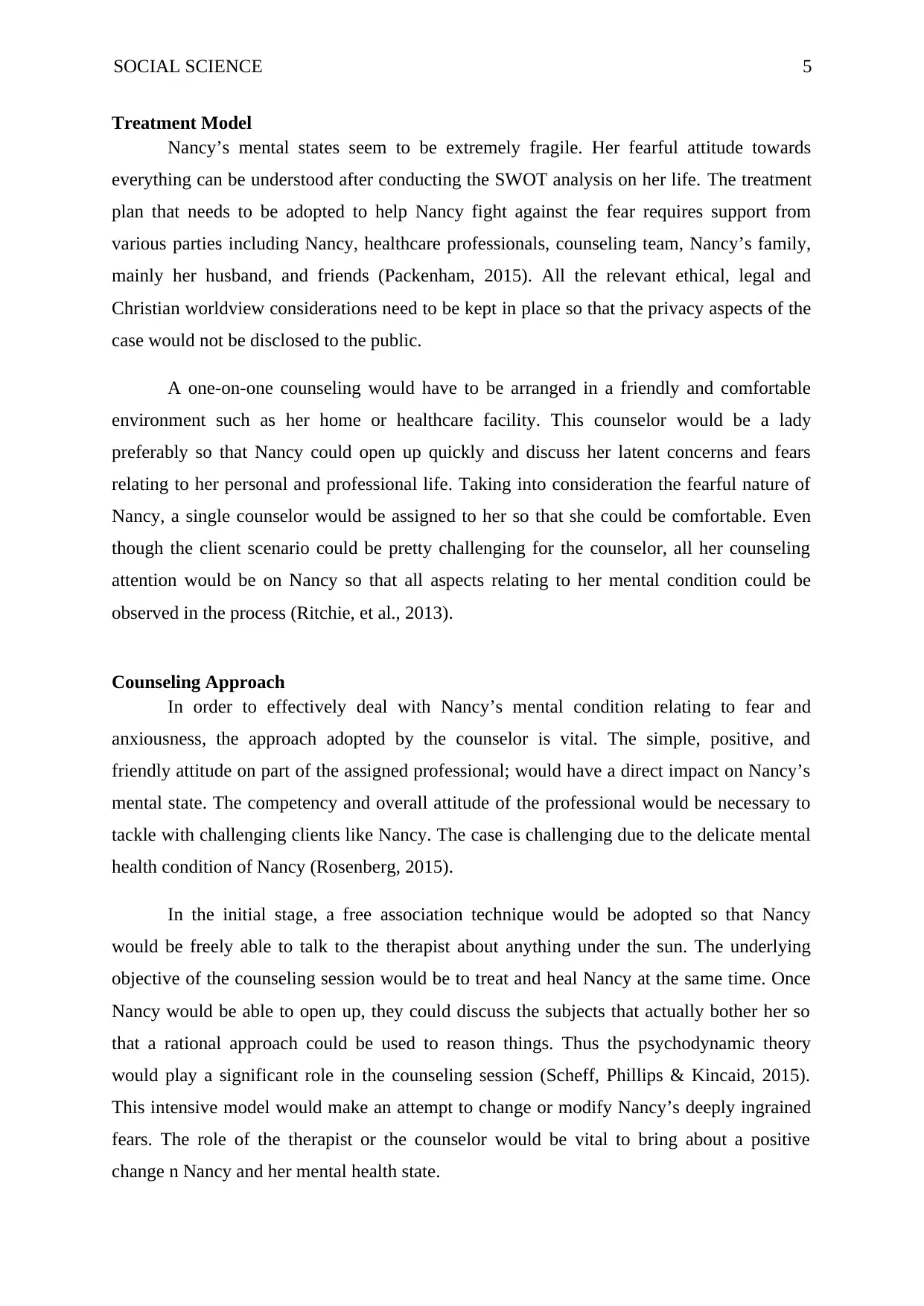
SOCIAL SCIENCE 5
Treatment Model
Nancy’s mental states seem to be extremely fragile. Her fearful attitude towards
everything can be understood after conducting the SWOT analysis on her life. The treatment
plan that needs to be adopted to help Nancy fight against the fear requires support from
various parties including Nancy, healthcare professionals, counseling team, Nancy’s family,
mainly her husband, and friends (Packenham, 2015). All the relevant ethical, legal and
Christian worldview considerations need to be kept in place so that the privacy aspects of the
case would not be disclosed to the public.
A one-on-one counseling would have to be arranged in a friendly and comfortable
environment such as her home or healthcare facility. This counselor would be a lady
preferably so that Nancy could open up quickly and discuss her latent concerns and fears
relating to her personal and professional life. Taking into consideration the fearful nature of
Nancy, a single counselor would be assigned to her so that she could be comfortable. Even
though the client scenario could be pretty challenging for the counselor, all her counseling
attention would be on Nancy so that all aspects relating to her mental condition could be
observed in the process (Ritchie, et al., 2013).
Counseling Approach
In order to effectively deal with Nancy’s mental condition relating to fear and
anxiousness, the approach adopted by the counselor is vital. The simple, positive, and
friendly attitude on part of the assigned professional; would have a direct impact on Nancy’s
mental state. The competency and overall attitude of the professional would be necessary to
tackle with challenging clients like Nancy. The case is challenging due to the delicate mental
health condition of Nancy (Rosenberg, 2015).
In the initial stage, a free association technique would be adopted so that Nancy
would be freely able to talk to the therapist about anything under the sun. The underlying
objective of the counseling session would be to treat and heal Nancy at the same time. Once
Nancy would be able to open up, they could discuss the subjects that actually bother her so
that a rational approach could be used to reason things. Thus the psychodynamic theory
would play a significant role in the counseling session (Scheff, Phillips & Kincaid, 2015).
This intensive model would make an attempt to change or modify Nancy’s deeply ingrained
fears. The role of the therapist or the counselor would be vital to bring about a positive
change n Nancy and her mental health state.
Treatment Model
Nancy’s mental states seem to be extremely fragile. Her fearful attitude towards
everything can be understood after conducting the SWOT analysis on her life. The treatment
plan that needs to be adopted to help Nancy fight against the fear requires support from
various parties including Nancy, healthcare professionals, counseling team, Nancy’s family,
mainly her husband, and friends (Packenham, 2015). All the relevant ethical, legal and
Christian worldview considerations need to be kept in place so that the privacy aspects of the
case would not be disclosed to the public.
A one-on-one counseling would have to be arranged in a friendly and comfortable
environment such as her home or healthcare facility. This counselor would be a lady
preferably so that Nancy could open up quickly and discuss her latent concerns and fears
relating to her personal and professional life. Taking into consideration the fearful nature of
Nancy, a single counselor would be assigned to her so that she could be comfortable. Even
though the client scenario could be pretty challenging for the counselor, all her counseling
attention would be on Nancy so that all aspects relating to her mental condition could be
observed in the process (Ritchie, et al., 2013).
Counseling Approach
In order to effectively deal with Nancy’s mental condition relating to fear and
anxiousness, the approach adopted by the counselor is vital. The simple, positive, and
friendly attitude on part of the assigned professional; would have a direct impact on Nancy’s
mental state. The competency and overall attitude of the professional would be necessary to
tackle with challenging clients like Nancy. The case is challenging due to the delicate mental
health condition of Nancy (Rosenberg, 2015).
In the initial stage, a free association technique would be adopted so that Nancy
would be freely able to talk to the therapist about anything under the sun. The underlying
objective of the counseling session would be to treat and heal Nancy at the same time. Once
Nancy would be able to open up, they could discuss the subjects that actually bother her so
that a rational approach could be used to reason things. Thus the psychodynamic theory
would play a significant role in the counseling session (Scheff, Phillips & Kincaid, 2015).
This intensive model would make an attempt to change or modify Nancy’s deeply ingrained
fears. The role of the therapist or the counselor would be vital to bring about a positive
change n Nancy and her mental health state.
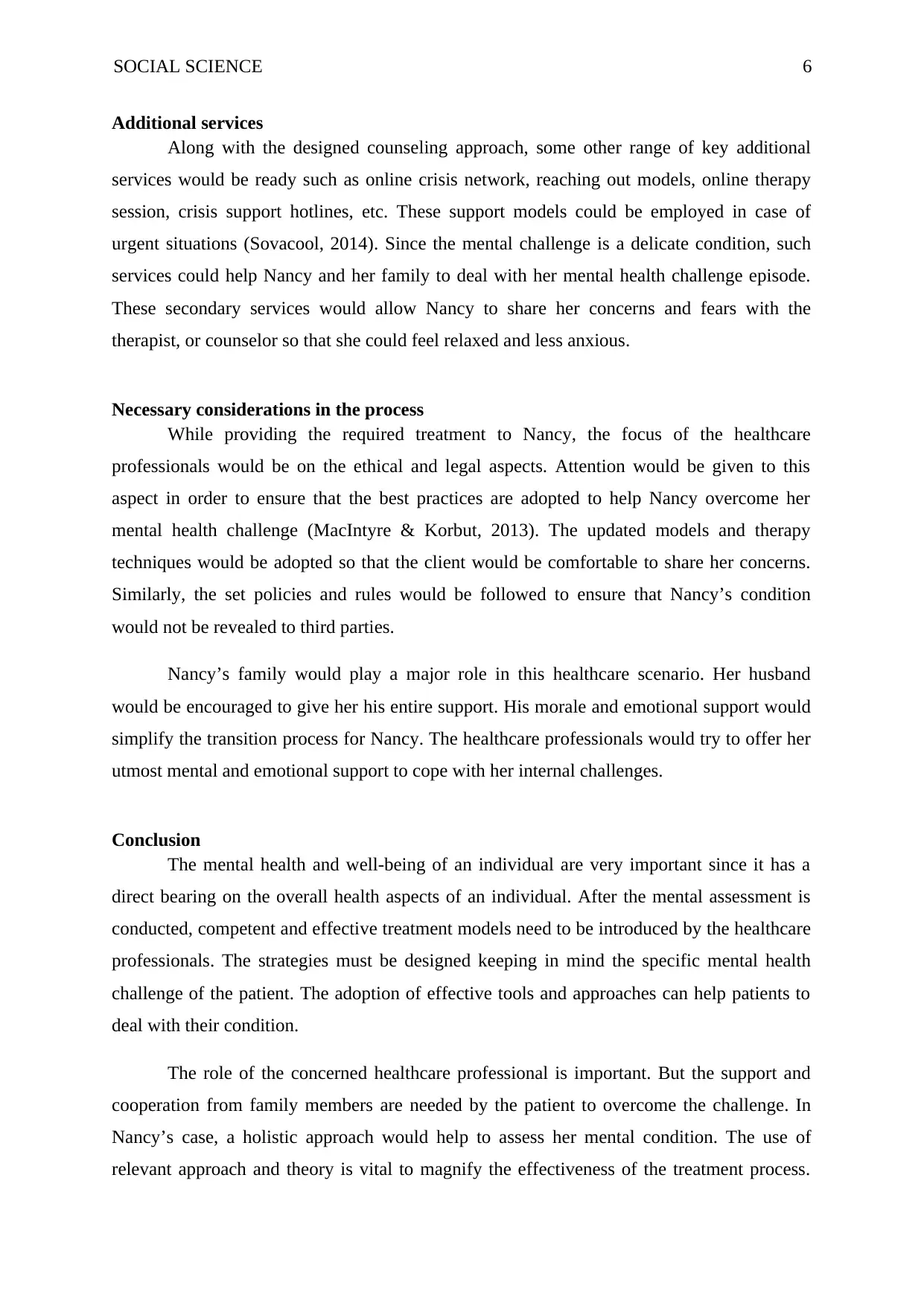
SOCIAL SCIENCE 6
Additional services
Along with the designed counseling approach, some other range of key additional
services would be ready such as online crisis network, reaching out models, online therapy
session, crisis support hotlines, etc. These support models could be employed in case of
urgent situations (Sovacool, 2014). Since the mental challenge is a delicate condition, such
services could help Nancy and her family to deal with her mental health challenge episode.
These secondary services would allow Nancy to share her concerns and fears with the
therapist, or counselor so that she could feel relaxed and less anxious.
Necessary considerations in the process
While providing the required treatment to Nancy, the focus of the healthcare
professionals would be on the ethical and legal aspects. Attention would be given to this
aspect in order to ensure that the best practices are adopted to help Nancy overcome her
mental health challenge (MacIntyre & Korbut, 2013). The updated models and therapy
techniques would be adopted so that the client would be comfortable to share her concerns.
Similarly, the set policies and rules would be followed to ensure that Nancy’s condition
would not be revealed to third parties.
Nancy’s family would play a major role in this healthcare scenario. Her husband
would be encouraged to give her his entire support. His morale and emotional support would
simplify the transition process for Nancy. The healthcare professionals would try to offer her
utmost mental and emotional support to cope with her internal challenges.
Conclusion
The mental health and well-being of an individual are very important since it has a
direct bearing on the overall health aspects of an individual. After the mental assessment is
conducted, competent and effective treatment models need to be introduced by the healthcare
professionals. The strategies must be designed keeping in mind the specific mental health
challenge of the patient. The adoption of effective tools and approaches can help patients to
deal with their condition.
The role of the concerned healthcare professional is important. But the support and
cooperation from family members are needed by the patient to overcome the challenge. In
Nancy’s case, a holistic approach would help to assess her mental condition. The use of
relevant approach and theory is vital to magnify the effectiveness of the treatment process.
Additional services
Along with the designed counseling approach, some other range of key additional
services would be ready such as online crisis network, reaching out models, online therapy
session, crisis support hotlines, etc. These support models could be employed in case of
urgent situations (Sovacool, 2014). Since the mental challenge is a delicate condition, such
services could help Nancy and her family to deal with her mental health challenge episode.
These secondary services would allow Nancy to share her concerns and fears with the
therapist, or counselor so that she could feel relaxed and less anxious.
Necessary considerations in the process
While providing the required treatment to Nancy, the focus of the healthcare
professionals would be on the ethical and legal aspects. Attention would be given to this
aspect in order to ensure that the best practices are adopted to help Nancy overcome her
mental health challenge (MacIntyre & Korbut, 2013). The updated models and therapy
techniques would be adopted so that the client would be comfortable to share her concerns.
Similarly, the set policies and rules would be followed to ensure that Nancy’s condition
would not be revealed to third parties.
Nancy’s family would play a major role in this healthcare scenario. Her husband
would be encouraged to give her his entire support. His morale and emotional support would
simplify the transition process for Nancy. The healthcare professionals would try to offer her
utmost mental and emotional support to cope with her internal challenges.
Conclusion
The mental health and well-being of an individual are very important since it has a
direct bearing on the overall health aspects of an individual. After the mental assessment is
conducted, competent and effective treatment models need to be introduced by the healthcare
professionals. The strategies must be designed keeping in mind the specific mental health
challenge of the patient. The adoption of effective tools and approaches can help patients to
deal with their condition.
The role of the concerned healthcare professional is important. But the support and
cooperation from family members are needed by the patient to overcome the challenge. In
Nancy’s case, a holistic approach would help to assess her mental condition. The use of
relevant approach and theory is vital to magnify the effectiveness of the treatment process.
⊘ This is a preview!⊘
Do you want full access?
Subscribe today to unlock all pages.

Trusted by 1+ million students worldwide
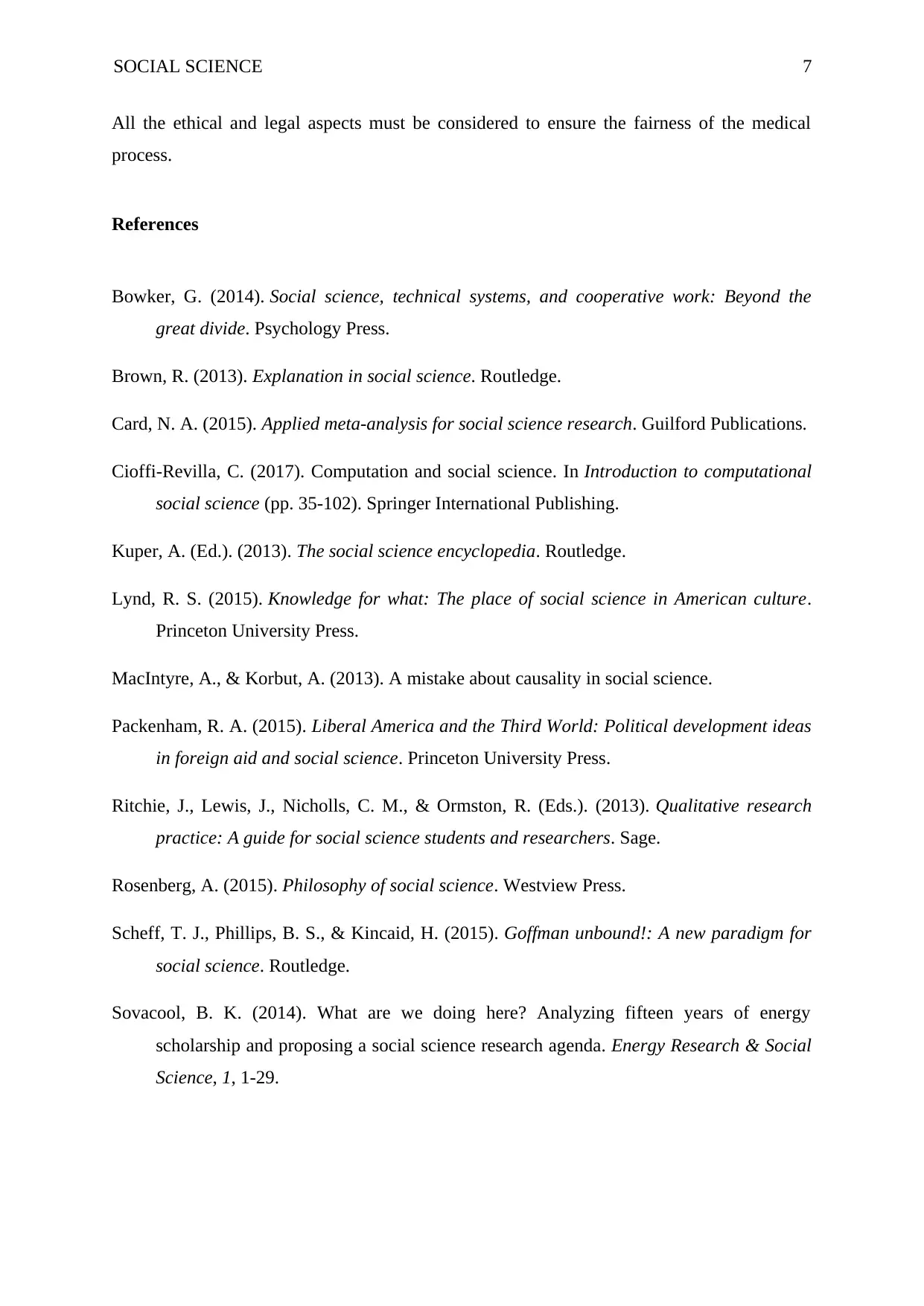
SOCIAL SCIENCE 7
All the ethical and legal aspects must be considered to ensure the fairness of the medical
process.
References
Bowker, G. (2014). Social science, technical systems, and cooperative work: Beyond the
great divide. Psychology Press.
Brown, R. (2013). Explanation in social science. Routledge.
Card, N. A. (2015). Applied meta-analysis for social science research. Guilford Publications.
Cioffi-Revilla, C. (2017). Computation and social science. In Introduction to computational
social science (pp. 35-102). Springer International Publishing.
Kuper, A. (Ed.). (2013). The social science encyclopedia. Routledge.
Lynd, R. S. (2015). Knowledge for what: The place of social science in American culture.
Princeton University Press.
MacIntyre, A., & Korbut, A. (2013). A mistake about causality in social science.
Packenham, R. A. (2015). Liberal America and the Third World: Political development ideas
in foreign aid and social science. Princeton University Press.
Ritchie, J., Lewis, J., Nicholls, C. M., & Ormston, R. (Eds.). (2013). Qualitative research
practice: A guide for social science students and researchers. Sage.
Rosenberg, A. (2015). Philosophy of social science. Westview Press.
Scheff, T. J., Phillips, B. S., & Kincaid, H. (2015). Goffman unbound!: A new paradigm for
social science. Routledge.
Sovacool, B. K. (2014). What are we doing here? Analyzing fifteen years of energy
scholarship and proposing a social science research agenda. Energy Research & Social
Science, 1, 1-29.
All the ethical and legal aspects must be considered to ensure the fairness of the medical
process.
References
Bowker, G. (2014). Social science, technical systems, and cooperative work: Beyond the
great divide. Psychology Press.
Brown, R. (2013). Explanation in social science. Routledge.
Card, N. A. (2015). Applied meta-analysis for social science research. Guilford Publications.
Cioffi-Revilla, C. (2017). Computation and social science. In Introduction to computational
social science (pp. 35-102). Springer International Publishing.
Kuper, A. (Ed.). (2013). The social science encyclopedia. Routledge.
Lynd, R. S. (2015). Knowledge for what: The place of social science in American culture.
Princeton University Press.
MacIntyre, A., & Korbut, A. (2013). A mistake about causality in social science.
Packenham, R. A. (2015). Liberal America and the Third World: Political development ideas
in foreign aid and social science. Princeton University Press.
Ritchie, J., Lewis, J., Nicholls, C. M., & Ormston, R. (Eds.). (2013). Qualitative research
practice: A guide for social science students and researchers. Sage.
Rosenberg, A. (2015). Philosophy of social science. Westview Press.
Scheff, T. J., Phillips, B. S., & Kincaid, H. (2015). Goffman unbound!: A new paradigm for
social science. Routledge.
Sovacool, B. K. (2014). What are we doing here? Analyzing fifteen years of energy
scholarship and proposing a social science research agenda. Energy Research & Social
Science, 1, 1-29.
Paraphrase This Document
Need a fresh take? Get an instant paraphrase of this document with our AI Paraphraser
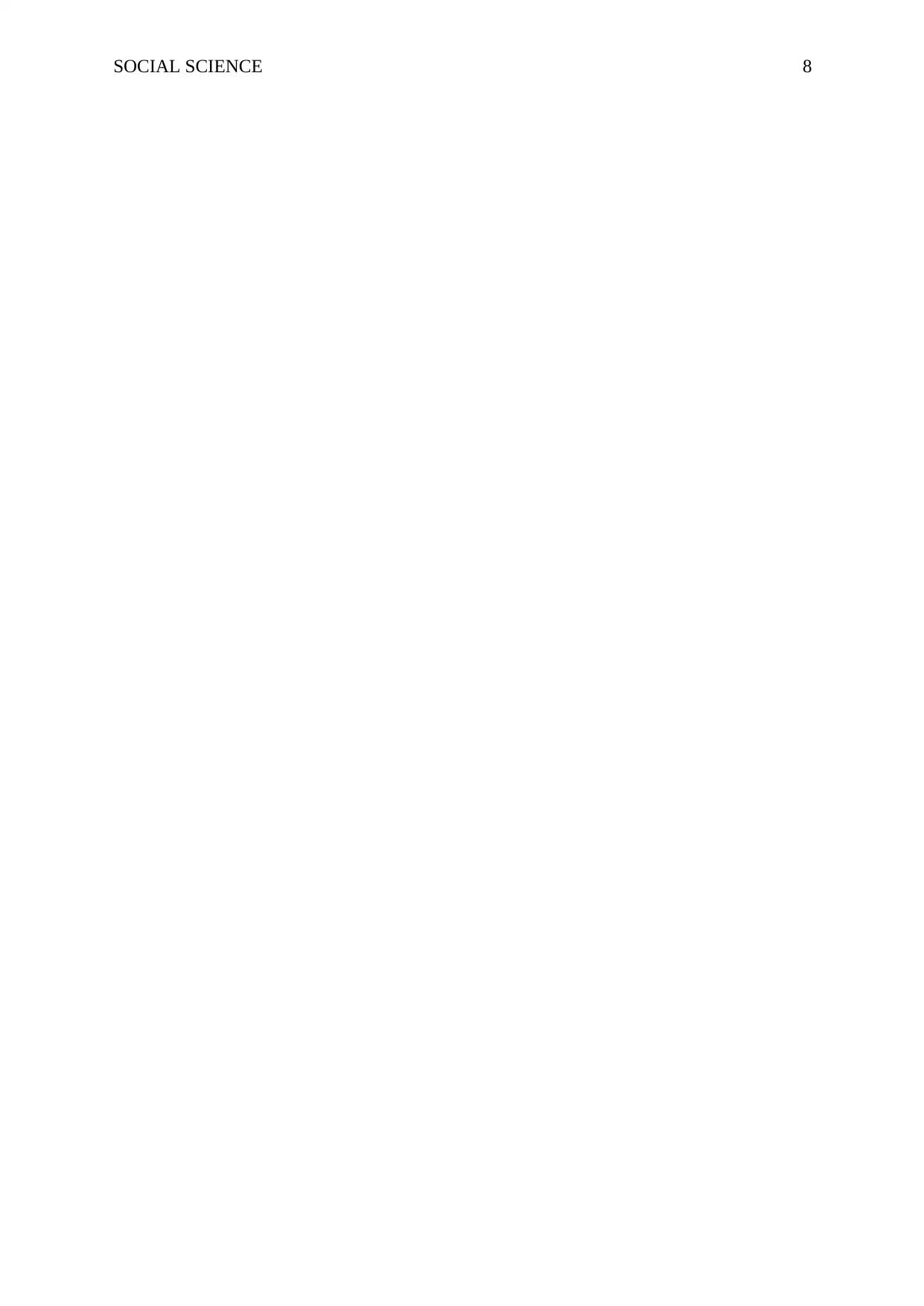
SOCIAL SCIENCE 8
1 out of 8
Related Documents
Your All-in-One AI-Powered Toolkit for Academic Success.
+13062052269
info@desklib.com
Available 24*7 on WhatsApp / Email
![[object Object]](/_next/static/media/star-bottom.7253800d.svg)
Unlock your academic potential
Copyright © 2020–2025 A2Z Services. All Rights Reserved. Developed and managed by ZUCOL.





